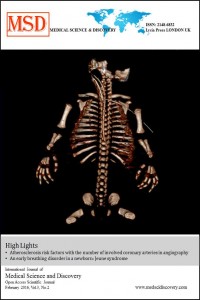Year 2016,
Volume: 3 Issue: 2, 107 - 8, 15.02.2016
Abstract
Honey bees are members of the hymenopteran family. The sting of honey bees venom can cause a range of effects from irritation to severe form of anaphylactic shock. Anaphylactic shock occurring after honey bee sting is reported in literature for about 5% of cases. Pericarditis occurring due to honey bee sting is a rare complication, which was previously not reported. We reported a case of pericarditis following a honeybee sting with late clinical manifestations. In our case, ECG demonstrated pericarditis at the third day of hospitalization as a late complication
References
- Witharana EW, Wijesinghe SK, Pradeepa KS, Karunaratne WA, Jayasinghe S. Bee and wasp stings in Deniyaya; a series of 322 cases. Ceylon Med J. 2015; 60(1):5-9.
- Wijerathna BT, Rathnayake GK, Agampodi SK. Hornet stings presenting to a primary care hospital in Anuradhapura district in Sri Lanka. J Wildness & Environmental Medicine 2014; 25: 122-6.
- Gruchalla RS. Immunotherapy in allergy to insect stings in children. N Engl J Med 2004; 351: 707-9.
- Kularatne SAM, Gawarammana IB, De Silva PHJG. Severe multiorgan dysfunction following multiple wasp (Vespa affinis) stings. Ceylon Med J 2003; 48: 146-7.
- Levine HD. Acute myocardial infarction following wasp sting. Report of two cases and critical survey of the literature. Am Heart J 1976; 91:365–74.
- Kounis NG, Mazarakis A, Tsigkas G, Giannopoulos S, Goudevenos J. “Kounis syndrome: a new twist on an old disease,” Future Cardiology 2011; 7 (6):805–824.
- Brasher GW, Sanchez SA. Reversible electrocardiographic changes associated with wasp sting anaphylaxis. JAMA 1974;229:1210–1211.
- Almpanis GC, A. Mazarakis DA. Dimopoulos et al. “The conundrumof hypersensitivity cardiac disease: hypersensitivity myocarditis, acute hypersensitivity coronary syndrome (Kounis syndrome) or both?” International Journal of Cardiology; 2011; 148(2):237–240.
Year 2016,
Volume: 3 Issue: 2, 107 - 8, 15.02.2016
Abstract
References
- Witharana EW, Wijesinghe SK, Pradeepa KS, Karunaratne WA, Jayasinghe S. Bee and wasp stings in Deniyaya; a series of 322 cases. Ceylon Med J. 2015; 60(1):5-9.
- Wijerathna BT, Rathnayake GK, Agampodi SK. Hornet stings presenting to a primary care hospital in Anuradhapura district in Sri Lanka. J Wildness & Environmental Medicine 2014; 25: 122-6.
- Gruchalla RS. Immunotherapy in allergy to insect stings in children. N Engl J Med 2004; 351: 707-9.
- Kularatne SAM, Gawarammana IB, De Silva PHJG. Severe multiorgan dysfunction following multiple wasp (Vespa affinis) stings. Ceylon Med J 2003; 48: 146-7.
- Levine HD. Acute myocardial infarction following wasp sting. Report of two cases and critical survey of the literature. Am Heart J 1976; 91:365–74.
- Kounis NG, Mazarakis A, Tsigkas G, Giannopoulos S, Goudevenos J. “Kounis syndrome: a new twist on an old disease,” Future Cardiology 2011; 7 (6):805–824.
- Brasher GW, Sanchez SA. Reversible electrocardiographic changes associated with wasp sting anaphylaxis. JAMA 1974;229:1210–1211.
- Almpanis GC, A. Mazarakis DA. Dimopoulos et al. “The conundrumof hypersensitivity cardiac disease: hypersensitivity myocarditis, acute hypersensitivity coronary syndrome (Kounis syndrome) or both?” International Journal of Cardiology; 2011; 148(2):237–240.
There are 8 citations in total.
Details
| Primary Language | English |
|---|---|
| Journal Section | Case Reports |
| Authors | |
| Publication Date | February 15, 2016 |
| Published in Issue | Year 2016 Volume: 3 Issue: 2 |


